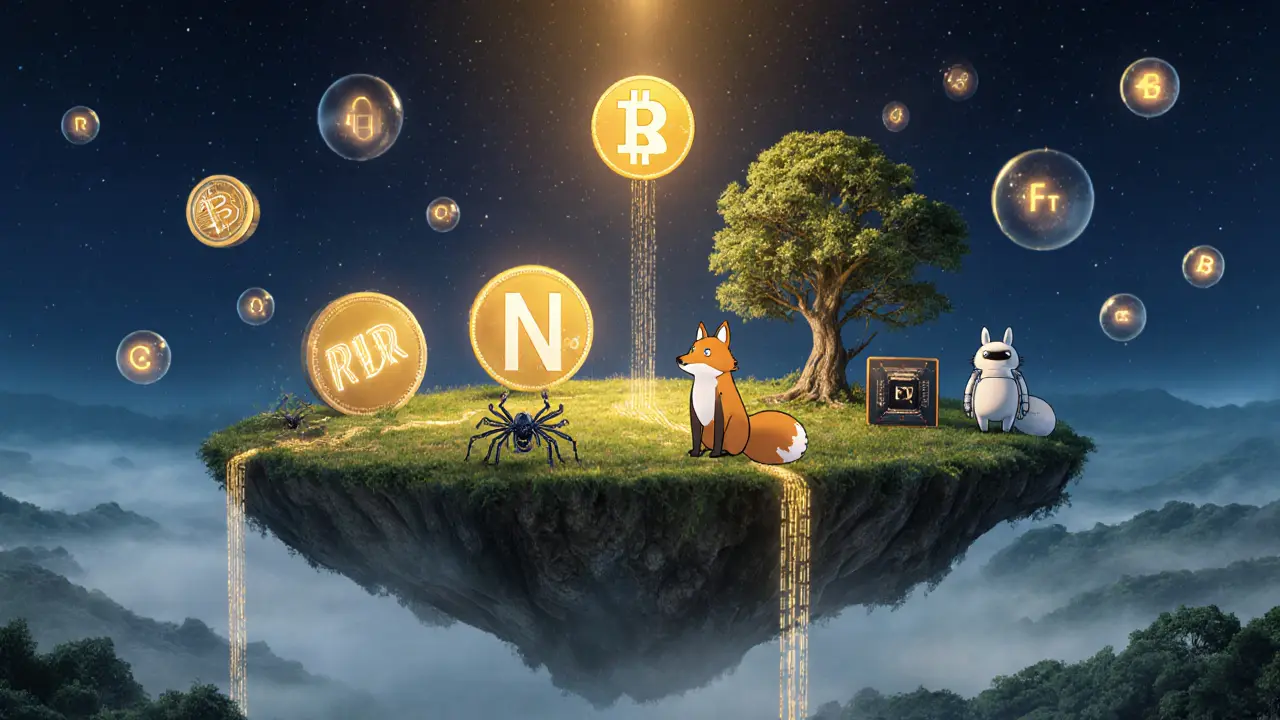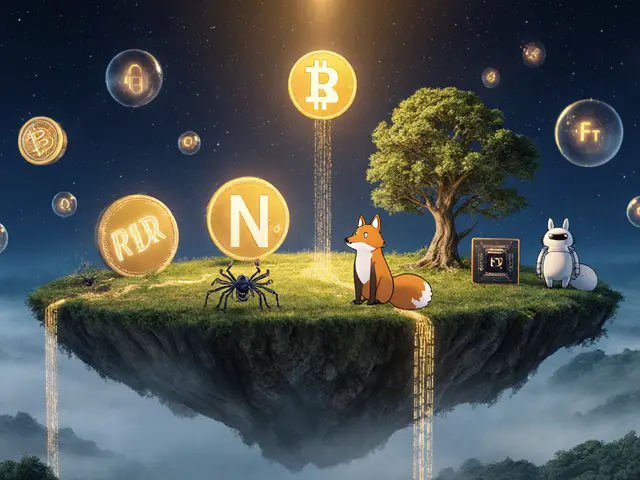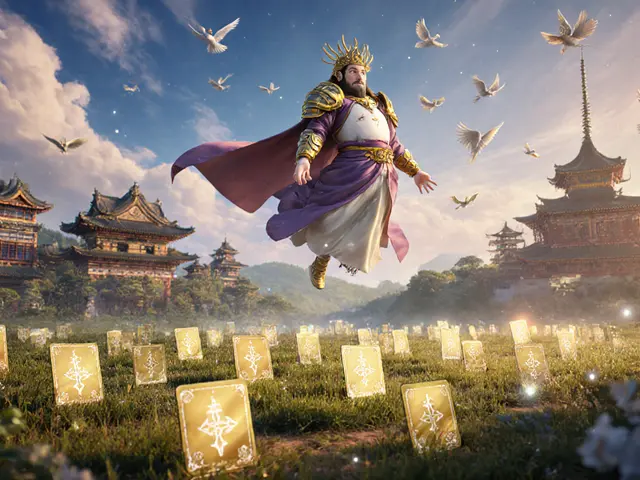18
Future of AI in Crypto Industry: How AI and Blockchain Are Merging in 2025

AI Compute Cost Calculator
Compare AI Compute Costs
Calculate how much you could save by using decentralized AI platforms like Render Network instead of centralized services like AWS.
Your Savings Report
Based on your inputs:
According to the article, platforms like Render Network (RNDR) offer 37% less cost than AWS for AI training. Your savings estimate aligns with this benchmark.
The future of AI in crypto isn’t just hype-it’s already reshaping how machines interact, trade, and learn without humans in the loop. By 2025, AI-driven cryptocurrencies aren’t speculative tokens anymore. They’re the fuel powering real-world systems: decentralized AI training, autonomous agents negotiating micro-payments, and data marketplaces where users get paid for their information. This isn’t science fiction. It’s happening right now, on blockchains that are learning to think.
What Exactly Are AI Cryptocurrencies?
Traditional crypto like Bitcoin is digital money. AI crypto is digital labor. These tokens-like RNDR, TAO, FET, and OCEAN-are designed to pay for computational work done by machines. Think of them as wages for AI models running on distributed networks instead of Amazon’s servers.
Render Network’s RNDR token, for example, lets users rent out idle GPU power from 1.2 million machines worldwide. Developers use it to train Stable Diffusion models at 37% less cost than AWS. Bittensor’s TAO token rewards AI models that give the most accurate answers to questions, creating a marketplace where models compete for credibility. The better the response, the more TAO it earns. No company owns this system. It’s run by code and incentives.
These aren’t just payment tools. They’re governance layers. Holders vote on upgrades, decide which AI models get priority access to compute, and even fund new research. This flips the script on Big Tech’s monopoly. OpenAI and Anthropic control 88% of AI-native company revenue. Amazon, Microsoft, and Google control 63% of cloud infrastructure. AI crypto is building an alternative.
How AI Makes Blockchain Smarter
It’s not just AI riding on blockchain-blockchain is making AI better. Traditional AI models are black boxes. You don’t know where the data came from, who trained it, or if it’s biased. Blockchain fixes that.
Ocean Protocol lets users tokenize and sell their data-health records, sensor readings, even social media behavior-while keeping it private. The blockchain logs every access, every payment, every use. In Q3 2025 alone, Ocean processed 12.7 million data transactions. No middleman. No data brokers. Just direct, auditable exchanges.
Smart contracts are getting smarter too. AI now predicts when a contract should trigger based on real-time market shifts, weather data, or supply chain delays. In finance, AI-enhanced contracts can auto-adjust loan terms if a borrower’s credit score drops. In logistics, they reroute shipments if a port shuts down. These aren’t theoretical. They’re live in pilot programs at 41 Fortune 500 companies.
Security is another win. Zero-knowledge proofs let AI models analyze encrypted data without ever seeing it. Homomorphic encryption lets you run calculations on encrypted data and get an encrypted result. You can verify a model’s output without exposing your private data. That’s huge for healthcare and finance.
The Tech Behind the Tokens
Not all AI crypto is built the same. There are three main architectures:
- Decentralized Compute Networks (42% of market): Render Network, Akash Network. They rent out GPU power. Transaction times average 2.3 seconds per AI inference.
- AI Data Marketplaces (31%): Ocean Protocol, SingularityNET. You sell data, models, or training sets. Verified by blockchain.
- Autonomous Agent Platforms (27%): Fetch.ai, Bittensor. AI bots buy, sell, negotiate, and execute tasks on your behalf. The x402 protocol handles micro-payments as small as $0.000001 in under 800 milliseconds.
Performance varies. Ethereum-based AI projects hit 1,200 transactions per second. Bitcoin? 7. But speed isn’t everything. AI crypto networks are 40% faster at finalizing transactions than traditional blockchains. That’s because AI predicts congestion and optimizes routing.
But there are limits. On-chain AI models are capped at 7 billion parameters. That’s tiny compared to GPT-4’s 1.8 trillion. So most heavy lifting still happens off-chain. The blockchain just verifies results, logs ownership, and handles payments. Hybrid systems are the future, not pure decentralization.
Real-World Use Cases That Work
People aren’t just holding these tokens. They’re using them.
A graphic design studio in Berlin, PixelPunch, cut its AI image generation costs by 40% in Q2 2025 by switching from Midjourney to a decentralized network using RNDR. They trained custom styles on their own data, owned the models, and didn’t pay monthly subscriptions.
On the other side, World Chain’s decentralized identity system verified 17 million users by August 2025. It proves you’re human without collecting your name, email, or phone number. No KYC. No tracking. Just a cryptographic proof.
Autonomous agents are making real trades. The x402 protocol handled 2.4 billion micro-transactions in Q4 2025. Think of it like a robot buying electricity from a neighbor’s solar panel, or an AI agent negotiating a better price for cloud storage across 10 providers in under a minute.
Even small developers are benefiting. One Reddit user, @CryptoAIguy, saved $2,300 in one month training Stable Diffusion models on RNDR instead of AWS. That’s real money. That’s real utility.
Why It’s Not All Smooth Sailing
There are serious problems.
First, volatility. AI crypto tokens are 55% more volatile than Bitcoin or Ethereum. One day you’re up 30%, the next you’re down 20%. That scares off institutions.
Second, energy use. Training AI on blockchain uses 35% more energy than centralized alternatives, according to Cambridge’s September 2025 study. Bittensor’s recent upgrade cut that by 33%, but it’s still a concern.
Third, complexity. You need to understand both AI and blockchain. Solidity or Rust for smart contracts. Python for machine learning. Cryptography for security. Consensys Academy says it takes 8-12 weeks just to get proficient. Most people give up.
Wallet integration is a nightmare. 28% of Trustpilot reviews mention it as the top complaint. You need MetaMask, Phantom, or a hardware wallet. Then you need to bridge tokens between chains. One wrong click and your funds are gone.
And then there’s the bubble risk. Matthew Tuttle of Tuttle Capital Management warns we’re in an AI tech bubble that could burst in the next 12 months. NeuralChain, a startup promising "decentralized AGI," collapsed in July 2025, stealing $8.7 million from users. It’s not just technical risk-it’s human greed.

Who’s Winning and Who’s Falling Behind
The market is concentrated. The top five AI crypto projects-Render, Bittensor, Fetch.ai, SingularityNET, and Ocean Protocol-control 68% of the $39 billion market. That’s not decentralization. That’s oligopoly.
Render Network leads in compute. Bittensor leads in model competition. Fetch.ai leads in agent frameworks. Each has a clear niche. Smaller projects? Most are dead by now. Grayscale Research predicts 70% of AI crypto projects will vanish in the next three years.
Enterprise adoption is slow but real. Financial services lead at 37% of implementations, followed by healthcare and supply chain. But only 12% have gone live. The rest are testing. Why? Compliance. The EU’s AI Act requires transparency, risk assessments, and human oversight. Most AI crypto projects can’t meet those standards yet.
Regulation is coming fast. 62% of industry experts expect stricter rules within 18 months. That’s good for the long-term. Bad for the hype-driven ones.
What’s Next? The Road to 2030
The biggest development on the horizon? The x402 protocol’s Q1 2026 update: multi-agent negotiation. Imagine 10 AI bots, each representing a different company, haggling over energy prices, data access, or delivery routes-all automatically, without humans. That’s the future.
MIT’s Digital Currency Initiative says it best: full decentralization won’t work. Hybrid systems will. Blockchain for trust, verification, and payments. Centralized servers for heavy AI training. That’s the only path that scales.
Gartner predicts a $30 trillion autonomous agent economy by 2030. That’s not a guess. It’s based on real adoption curves in logistics, finance, and energy. If even 1% of that moves onto blockchain, AI crypto will be worth trillions.
But here’s the truth: most people won’t interact with AI crypto directly. They’ll use apps powered by it. A weather app that pays you for sharing your local data. A trading bot that auto-invests your crypto using decentralized AI. A health platform that lets you sell your anonymized records to researchers.
The revolution isn’t in wallets. It’s in the background. Quiet. Efficient. Unseen. And that’s when it becomes unstoppable.
Are AI cryptocurrencies a good investment?
AI crypto isn’t a simple buy-and-hold asset. It’s infrastructure. Tokens like RNDR and TAO have value because they’re used-like electricity or cloud computing. If you’re investing, focus on projects with real usage, not hype. Look at daily active models, transaction volume, and developer activity. Avoid tokens with no clear utility or team anonymity. Volatility is extreme, and 70% of projects will likely fail by 2028.
Can I use AI crypto without being a developer?
Yes, but it’s still clunky. Apps like World Chain let you verify your identity without sharing personal data. Some AI trading bots now accept TAO or RNDR as payment. But most tools require wallet setup, gas fees, and cross-chain bridges. For non-tech users, it’s easier to use centralized AI services today. The user experience will improve, but not until 2026-2027.
How is AI crypto different from AI stocks like NVIDIA or Microsoft?
AI stocks are centralized. NVIDIA sells chips. Microsoft sells Azure AI. You’re betting on one company’s success. AI crypto is decentralized. Thousands of independent GPU owners, data providers, and AI models compete. You’re betting on an open system. It’s riskier, but if it works, it breaks Big Tech’s control. One is a stock. The other is a new economic layer.
Is AI crypto regulated?
Not yet, but it’s coming fast. The EU’s AI Act requires transparency, accountability, and human oversight-things most AI crypto projects can’t deliver. The SEC is watching. In 2025, 68% of AI crypto projects operating in Europe failed to meet compliance standards. Expect classification as securities or utility tokens by 2026. Projects without clear use cases will be shut down.
What’s the biggest threat to AI crypto?
The biggest threat isn’t technology-it’s centralization. If a few large players dominate compute networks or data pools, AI crypto becomes just another corporate monopoly. Energy use and regulatory crackdowns are serious, but the real risk is losing the decentralized promise. If the system becomes as controlled as AWS or OpenAI, it defeats the whole point.
How do I get started with AI crypto?
Start small. Learn the basics of Ethereum and MetaMask. Then try Render Network’s platform-rent a GPU for $5 to train a simple image model. Use Bittensor’s testnet to see how models earn TAO. Read developer docs from Fetch.ai and Ocean Protocol. Don’t invest money until you’ve used the tools. GitHub contributors recommend starting with pre-built agent templates. It saves 20+ hours of debugging.








